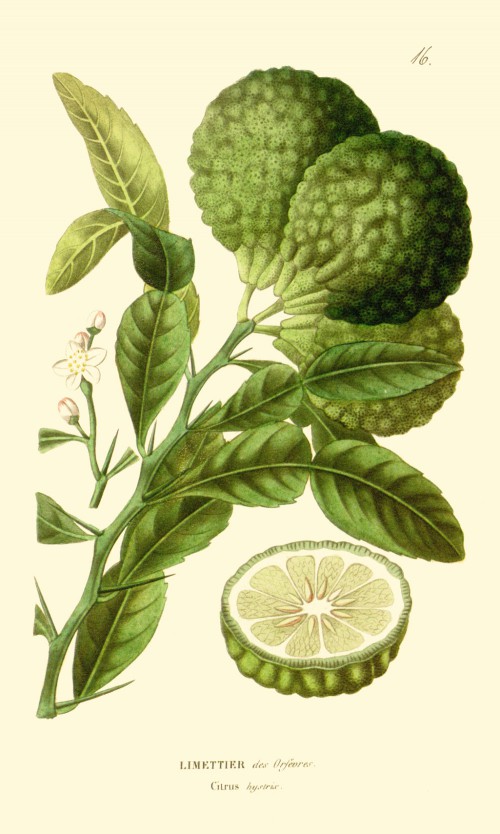Citrus hystrix DC. - syn. Citrus torosa Blanco - Rutaceae - Kaffir lime, Mauritius papeda, Kaffernlimette, Kaffir-Limette, Makrut-Limette, Langdorniger Orangenbaum
Tree 3-6 m tall, exact native range obscure, probably tropical Asia, naturalized and cultivated there; branchlets with spines; leaves dark red when young, ovate, margin apically conspicuously and sparsely crenate, apex narrowly obtuse; inflorescences with (1 or)3-5 flowers; flower buds globose, calyx lobes 4 or 5, broadly triangular,petals white but pinkish red outside, 7-10mm; fruit lemon yellow, ellipsoid to subglobose, 5-7 × 3-5 cm, slightly coarse or smooth, oil dots numerous and prominent.
„Selected forms are cultivated throughout the warm parts of the world for their culinary (leaves) and medicinal (fruit) uses. All named taxa (save perhaps some from central Malesia) seem to have been based on cultivated plants as discussed by Mabberley (Gard. Bull. Singapore 54: 173-184. 2002).“
http://www.efloras.org/florataxon.aspx?flora_id=2&taxon_id=242313263
„(−)-Citronellal was characterized as the main component (81%) of the leaf oil. It was also found as the main component of the twig oil (78.64%), and a major component of the peel oil (23.64%) in combination with β-pinene (25.93%) and sabinene (20.36%). In total 57 constituents were characterized in the leaf oil. 2,6-Dimethyl-5-heptenal, citronellic acid, and safrole were some of the more unusual components found in the various oils of C. hystrix. An extract of the juice, which was found to contain β-pinene (39.50%) and terpinen-4-ol (17.55%), was not very similar in composition to an extract of the peel. This latter extract, which contained β-pinene (31.54%), sabinene (15.57%) and citronellal (16.80%), was qualitatively relatively similar in composition to the peel oil.“
[The chemical composition of Citrus hystrix DC (Swangi)., Sato, A., Asano, K., Sato, T., Journal of Essential Oil Research, 2(4), 1990, 179-183]
The essential oil obtained by steam distillation (2.5%) or SDE (dichloromethane, 1.8%) from fresh leaves of C.hystrix from Malaysia contained mainly citronellal (61.7%; 72.4% resp.) and ß-citronellol (13.4%; 10.3% resp.). Minor components were sabinene, limonene, linalool, citronellyl acetate and nerolidol eg. The peel oil is predominated in β-pinene, sabinene and limonene.
„In Malaysia, this plant is usually planted in the house garden together with other plants such as lemon grass, ginger, galanga and fragrant pandan. Its pear-shaped fruit with highly wrinkled skin of intense green colour was traditionally used among the Malaysian folks for washing their hairs and other parts of the body in bathing ceremony called ‘mandi berlimau’, and in certain occasion was used in getting rid of evil spirit.
Currently, the C. hystrix peel is used as perfume in shampoos and its leaves are often used as a food lavouring ingredient in making ‘laksa asam’ sauce, curries, cakes, satay and tomyam soup, an Asean delicacy
(Wong 1992; Muhammad Nor 1992a).
[Volatile aroma compounds in Citrus hystrix oil., Nor, O.M., J. Trop. Agric. Food Sci, 27, 1999, 225-229]
„The effects of kaffir lime oil [fresh fruit peel oil, hydrodistillation, 1.5%] on human autonomic and behavioural parameters after massage were investigated… Regarding the behavioural parameters, subjects in the kaffir lime oil group rated themselves more alert, attentive, cheerful and vigorous than subjects in the control group. These findings are likely to represent stimulating/activating effects of the kaffir lime oil and provide some evidence for the use of kaffir lime oil in aromatherapy, such as causing relief from depression and stress in humans…
The oil mainly consisted of monoterpene hydrocarbons, with limonene (30.73%) and β-pinene (18.76%) as the main components. Other minor components were terpinene-4-ol (10.63%), α-terpineol (8.35%), γ-terpinene (6.18%), α-terpinene (5.09%) and terpinolene (4.33%).“
[Chemical composition and stimulating effect of Citrus hystrix oil on humans., Hongratanaworakit, T., Buchbauer, G., Flavour and fragrance journal, 22(5), 2007, 443-449]
38 constituents were identified in the essential oil from C.hystrix leaves from New Caledonia. Major components were terpinen-4-ol (13.0%), β-pinene (10.9%), α-terpineol (7.6%), 1,8-cineole (6.4%), citronellol (6.0%), limonene (4.7%), p-mentha-2,4(8)-diene (3.8%), α-pinene (3.6%), linalool (2.8%), citronellal (2.7%), p-menth-8-en-3-ol (2.6%), citronellyl acetate (2.2%) and carvacrol (1.2%). The oil was inactive against five bacteria and five fungi strains.
[Chemical composition and antimicrobial activity of the essential oils from New Caledonian Citrus macroptera and Citrus hystrix., Waikedre, J., Dugay, A., Barrachina, I., Herrenknecht, C., Cabalion, P., Fournet, A., Chemistry & biodiversity, 7(4), 2010, 871-877]

Annales de flore et de pomone: ou journal des jardins et des champs, ser.3, vol.1 t.16 (1817)
http://plantgenera.org/species.php?id_species=249865

citrus hystrix foliage and fruit; Bellingen, Australia, Author: Robyn Jay from Sydney, Australia -
kaffir limes Uploaded by berichard Wikimedia Commons
https://creativecommons.org/licenses/by-sa/2.0/
